|
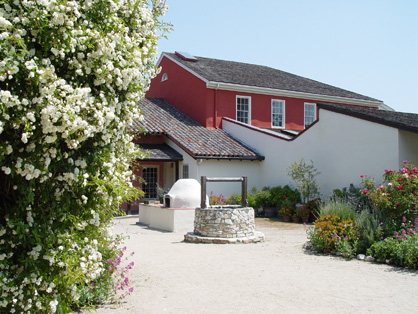
Cooper-Molera
Adobe Garden
THE
COOPER-MOLERA ADOBE
History
of the Cooper-Molera Adobe
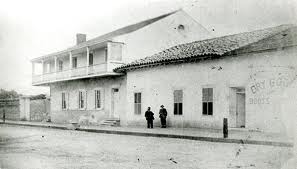
Vintage
Photograph of the Cooper-Molera Adobe
The
Cooper-Molera Adobe, built over three generations beginning in the 1830s and
fully restored in the 1980s, encapsulates the story of a multi-ethnic family
with Mexican, Spanish, Californio, English and American members.
The
home was built by John (Juan Bautista) Rogers Cooper, a ship captain from
New England who settled in Alta California when it was part of Mexico and
married into a prominent Californio family, the Vallejos. Cooper traveled
extensively by sea and land, trading in hides, tallow, general merchandise,
and sea otter pelts that were highly prized in China. On display at the adobe
are the elegance and wealth of the family after statehood was achieved and
the house was expanded in 1850.
As
the site of a townhouse that also accommodated a limited amount of livestock
and agriculture, the site includes barns, vegetable gardens, a small orchard,
and housing for farm animals. The
two-story Casa Cooper-Molera contains an unusually complete complement of
original family furnishings acquired over time as prosperity increased. The
grounds contain period structures that pre-date and post-date the main house,
reflecting a broad sampling of California’s architectural history. Visiting
this 2.5 acre site in the center of downtown Monterey, California’s
capital under both Spain and Mexico, brings history to life right up through
the early American era.
In
1971, when California State Parks began planning to operate the Cooper-Molera
Adobe, they described it as “the
vehicle for the most exciting and relevant historical interpretive effort
in the Monterey Area, if not in the entire State.”
Grade
school children visit each year to learn how to make adobe bricks in the garden.
The adobe and grounds are also a part of Living History Day and Christmas
in the Adobes.
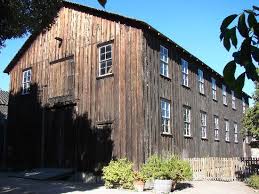
One
of the Barns within the Cooper-Molera Complex
Original
Development Proposal
Unfortunately,
the adobe is not financially viable for the property owner, the National Trust
for Historic Preservation. They are looking for ways to commercialize the
site.
The
original development proposal included: (1) conversion of the ground floor
of the Cooper Adobe and the Diaz Adobe to a table-service restaurant (a later
alternative proposed a restaurant in the Cooper Adobe and retail in the Diaz
Adobe); (2) conversion of the Spear Warehouse into a wine bar and the Corner
Store into a café (a later alternative proposed retail in the Corner
Store); and (3) creation of a large event center in the barns, following a
substantial rehabilitation and seismic retrofit. (The barns are currently
red-tagged for seismic reasons, and not open to the public under any circumstances.)
Two new kitchen facilities, appropriately designed and sited, would be needed
to support the proposed commercial food service operations. Common areas within
the interior of the property would be maintained in their open configurations,
but with portions adapted and repurposed to accommodate the commercial activities.
AMAP
Involvement
This
proposal was not acceptable to AMAP nor the Monterey State Historic Park Association
(MSHPA).
Both organizations expressed concern that commercial development of the site
would adversely affect its historic character and public educational and interpretive
programming, and that the proposal represented the prospective loss of a public
historic site that has been operated as part of the Monterey State Historic
Park for some 30 years.
AMAP
board members, along with MSHPA, have been working with the National Trust
since June of 2013 to make the property sustainable and profitable while at
the same time maintaining the site as a living history museum.
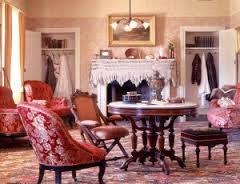
Interior
of the Cooper-Molera Adobe
The
New Vision for the Cooper-Molera Adobe
Now,
largely due to efforts of AMAP and others, the current plan is much more compatible
with the historic nature of this important Monterey landmark. The current
plan includes
a variety of nonprofit and commercial uses, and which may create opportunities
for new or expanded partnerships with California State Parks, MSHPA, other
local cultural institutions, the City of Monterey, and others within the local
community.
The
new approach is one that would still introduce compatible commercial functions
at the site, but maintain an active program of historic interpretation, centered
within the Cooper and Diaz Adobes but integrated throughout the site. It is
believed that this model will actually create greater opportunities to engage
the public at Cooper-Molera, and to maintain the property as a community asset.
The
four principal components of the current vision are as follows: (1) an
active historic interpretation and public education program, centered
on the Cooper and Diaz Adobes, but taking full advantage of all other
site assets, including other structures on the property, as well as the
gardens and grounds; (2) compatible retail use of the Corner Store and
the Corner Store Addition; (3) compatible use of the Spear Warehouse and
adjacent yard for restaurant services and catering services within the
site; and (4) adaptation of the Barns for private and public events, ranging
from weddings to educational, theatrical, and other arts-oriented uses.
It
is hoped that the final plan will allow the
house and garden to be maintained primarily as a living history museum with
only limited, compatible, and appropriate commercial activity. In this way,
both public benefit and economic vitality will be maintained.
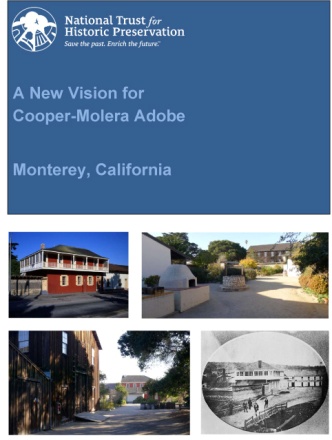 You
may read the entire report
You
may read the entire report
("A
New Vision for Cooper-Molera Adobe, Monterey, California")
by
Clicking
Here.
The
Cooper-Molera Adobe Fund will support and protect the gift of Frances
Molera, especially historical education programs for children. You may
donate by clicking the button below.
; |